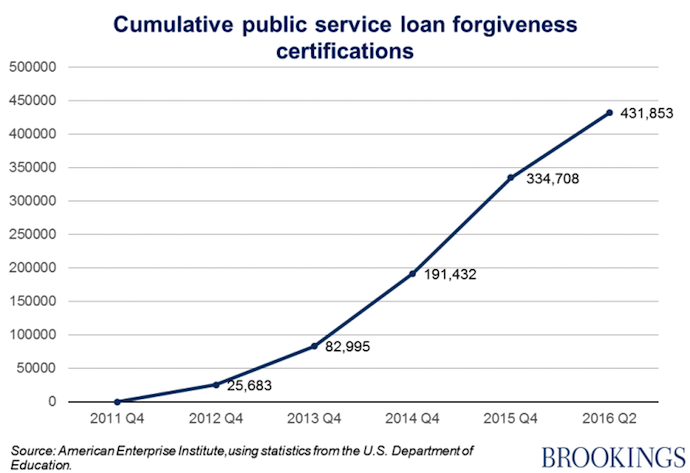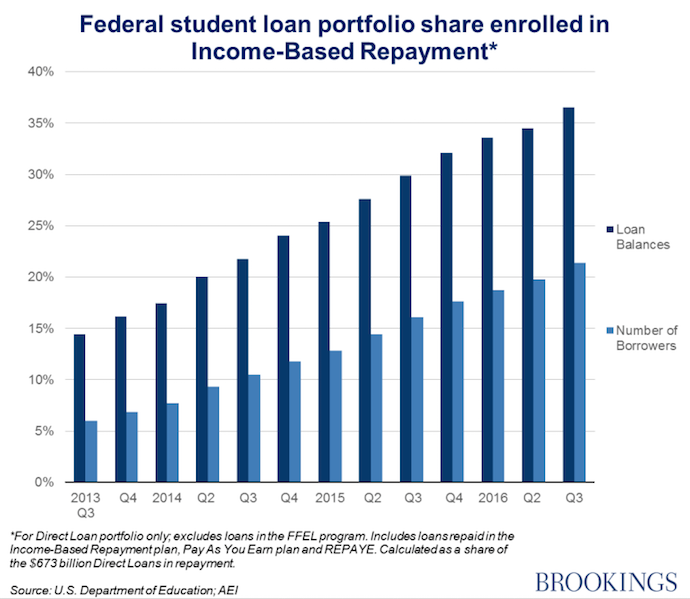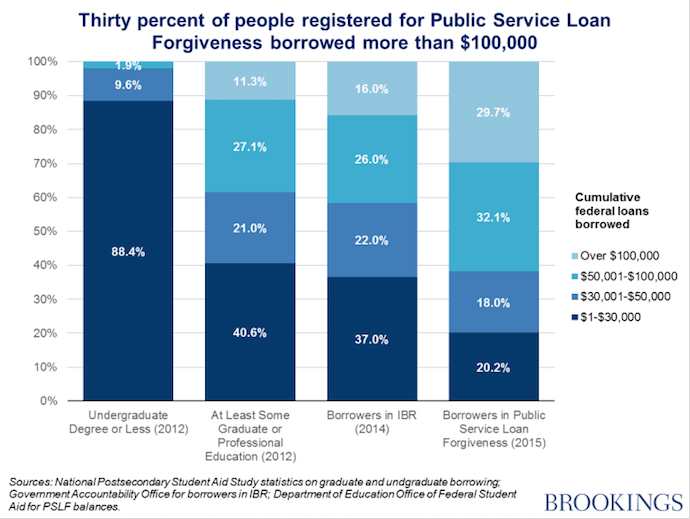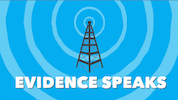Executive Summary
The federal government is making more data available about the performance of the Public Service Loan Forgiveness (PSLF) program for federal student loans. Many policymakers are not aware of this program, but the new data reveal PSLF is growing rapidly and is larger than most observers expected. Budget agencies recently revised the projected cost of the program upward by a staggering amount, and the U.S. Department of Education reports that many PSLF enrollees borrowed over $100,000 to finance graduate degrees. Recent research suggests that borrowers in certain professions stand to have their entire graduate and professional educations paid for through loan forgiveness under PSLF. In light of these developments, reforms that limit the most excessive features of PSLF are warranted, although repealing PSLF altogether and letting the federal Income-Based Repayment program (IBR) accomplish the goal of PSLF is an even better course of action.
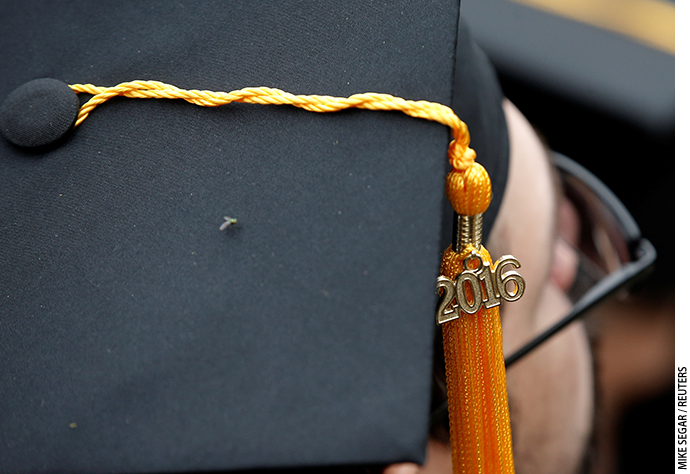
Introduction
This campaign season, candidates on both sides of the political aisle have said the federal government should help public service workers repay their student loans. During his failed bid for the Republican presidential nomination, Governor John Kasich said, “I think we can seriously look at an idea of where you can…pay off some of that debt through the public service that you do.” [i] Outlining his student loan plan in the Washington Post last year, erstwhile presidential candidate Governor Martin O’Malley wrote, “we should cap the monthly payments on students’ loans, so students whose passion is teaching or policing or national service can pursue their dreams without worrying about debt or default.” [ii] Democratic nominee Hillary Clinton has expressed her intent to “forgive [student] loans for people who do public service jobs after a period of time.” [iii]
Presidential candidates and other policymakers may be surprised to learn that the federal government already offers a broad and generous loan repayment program for public service workers. But the latest statistics suggest that the government does too much to help borrowers in public service jobs repay their loans, not too little. Recent figures on budget costs, enrollment, and projected loan forgiveness all point to a public service loan forgiveness bonanza on the horizon—one that will significantly distort incentives and pricing in higher education and disproportionately benefit borrowers with graduate and professional degrees.
Policymakers can be forgiven for missing these trends. Key information about the Public Service Loan Forgiveness program is hard to come by. What is available is scattered across obscure government PowerPoint presentations and spreadsheets. Pulling that information together just might convince Hillary Clinton and other lawmakers that the government already provides a large public service loan forgiveness program, and that the more apt proposal would be to rein it in, not expand it.
What are Income-Based Repayment and Public Service Loan Forgiveness?
First, let’s review how these programs work. Anyone with a federal student loan who works in public service can currently cap his monthly payments at a fixed share of his income and the government will forgive all remaining debt after 10 years. [iv] Two distinct programs are at work here: Income-Based Repayment (IBR) and Public Service Loan Forgiveness (PSLF). Both were enacted in 2007, but the Obama administration enacted policies to make them significantly more generous in 2010, 2012, and again in 2015.[v]
Income-Based Repayment. Through IBR, any borrower can cap payments on his loans at 10 percent of a portion of his income, which is calculated by deducting 150 percent of the poverty line for his household size ($17,655 for a single person without dependents) from the adjusted gross income stated on his federal tax return. Adjusted gross income usually reflects less than a borrower’s total income because it excludes the income a borrower contributes to a long list of common pre-tax benefits, such as health insurance premiums, retirement savings, and even employee parking and transit expenses. It also excludes a borrower’s payments on student loan interest, creating a double benefit.
IBR also goes by two other names, Pay As You Earn (PAYE) and Revised Pay As You Earn (REPAYE), but the benefits are nearly identical across all three. For simplicity, this piece will collectively refer to the programs as IBR. [vi] Note that borrowers may use IBR regardless of the type of job they have. It is not limited to public service employees.
To understand how IBR works, consider a hypothetical individual with an adjusted gross income of $45,000—total earnings of $50,000—and a student loan balance of $50,000. IBR has him pay $227 per month on his loan instead of the $530 he would pay on the traditional 10-year repayment plan. [vii] After 20 years of payments, the federal government forgives all remaining unpaid interest and principal. Prior to the Obama administration’s changes, payments were 15 percent of income, which in that example would result in a $340 monthly payment, or 50 percent more than what borrowers now pay under IBR. Loan forgiveness also kicked in not after 20 years but 25.
Public Service Loan Forgiveness. Under the separate PSLF program, borrowers employed full-time in a public service occupation who use IBR receive loan forgiveness much sooner—after only 10 years of payments (technically 120 cumulative monthly payments). [viii] When the Obama administration reduced the monthly payments borrowers make in IBR, it also increased the benefit of PSLF by a substantial amount. Had the administration left the original IBR program in place, borrowers would have paid 50 percent more before having their remaining debt forgiven under PSLF.
Unlike other loan forgiveness programs targeted at certain professions, PSLF defines public service broadly enough to encompass a quarter of the U.S. workforce. [ix] Eligible employment includes any position at a federal, state, or local government entity, or non-profit organization with a 501(c)(3) designation, or another non-profit organization that does not have 501(c)(3) status but provides emergency management, public safety, or law enforcement services; health services; education or library services; school-based services; public interest law services; early childhood education; or public services for individuals with disabilities and the elderly. [x]
PSLF costs are skyrocketing
Many observers initially dismissed PSLF as a program that few borrowers would use. It was hard for them to see how the terms of repayment translated into substantial benefits for borrowers. Now that new information about how the program is working is coming in, some people are rethinking their first impressions.
The Obama administration understands that spending on PSLF needs to be reined in. The administration’s proposals do not go nearly far enough, as I argue and document subsequently, and they have not obtained traction on the Hill. Nevertheless, the proposed reforms give us a window into the runaway costs of the program as scored by the non-partisan Congressional Budget Office (CBO). In 2014, the CBO estimated that the Obama administration’s proposal to cap the amount that could be forgiven under PSLF at $57,500 would save $265 million over 10 years (2015 to 2024). [xi] The agency recently revised that figure to $6.7 billion. [xii]
The CBO revised its estimates by a similar magnitude for a related change to PSLF proposed by the Obama administration. Borrowers make payments based on their income only up to a certain point in IBR. Once a borrower’s income reaches a level where his loan payment would be higher than under a traditional 10-year repayment term for his original loan balance, the program by default has him pay the lower of the two amounts. The Obama administration proposed eliminating this cap, which would thus require some borrowers to pay more and therefore have less forgiven under PSLF. [xiii] The CBO originally estimated the proposal would save $135 million, which stems from reducing the amount of loan forgiveness borrowers get under either PSLF or IBR’s 20-year forgiveness benefit. In 2016, the CBO raised that estimate to $5.4 billion. [xiv]
In other words, as indicated in the table below, the CBO estimates that just two features of IBR and PSLF that favor those with the largest loans and incomes will cost the taxpayer over $12 billion in forgiven loan repayments over the next 10 years.
| 10-year budget savings from Obama administration’s proposed changes to Public Service Loan Forgiveness (in billions) | ||
| 2014 estimate | 2016 estimate | |
| Cap loan forgiveness at $57,500 | $0.265 | $6.685 |
| Remove 10-yr plan repayment cap* | $0.135 | $5.365 |
*Only a portion of savings are related to PSLF.
Source: Congressional Budget Office.
Enrollment in PSLF and IBR is booming
One reason why government agencies like the CBO are changing their outlook on PSLF is that enrollment is growing rapidly. To be sure, gauging enrollment in PSLF is tricky because borrowers can retroactively claim benefits for work and payments as far back as 2007. They can work in a qualified job, make the requisite number of payments for 10 years, and then submit all the paperwork to the Department of Education to have their remaining debt forgiven. However, the Department developed an optional certification process in 2012 so that borrowers and the government have more clarity and certainty about who qualifies and is enrolling in PSLF. Borrowers may (but are not required to) submit a form to the Department documenting their qualifying loan payments, and the Department will determine whether they qualify for PSLF. [xv] Borrowers can thus have their accumulated credit toward PSLF certified as they work and make payments.
These certifications provide a sense of how many borrowers are “enrolled” in PSLF, although many more who opt not to submit a verification form will qualify retroactively. The latest data show that there are 431,853 borrowers enrolled in PSLF, a number that has been growing rapidly. Around 38 percent of these borrowers are employed at non-profit organizations, and the majority are employed at a government entity. [xvi] Most enrollees are in their first few years of payments, suggesting that older cohorts of qualified borrowers are unaware of the certification process or are opting not to use it. [xvii] Indeed, the Government Accountability Office (GAO) finds that many eligible borrowers are not aware of PSLF and the enrollment growth comes despite little effort from the Department of Education to promote the program or further simplify the verification process. [xviii] In all, the GAO says that 25 percent of the workforce is employed in a job that qualifies for PSLF, although it is unclear how many have federal student loans, are enrolled in IBR, or even know about PSLF. [xix]
Another indicator of the potential size and scope of PSLF is enrollment in IBR. There, too, the growth has exceeded almost everyone’s expectations, now totaling over 20 percent of borrowers and 36.5 percent of the outstanding federal student debt in repayment. [xx] Although many borrowers will use IBR as a repayment tool without any plans to use PSLF, all borrowers who receive PSLF must use IBR for part of their repayment term to receive any loan forgiveness.
PSLF borrowers have unusually high loan balances
Those who thought PSLF would be a small-scale program likely did not foresee that borrowers enrolled in PSLF would have some of the highest loan balances in the federal student loan program. The median debt load of those enrolled in PSLF exceeds $60,000, and nearly 30 percent of PSLF enrollees borrowed over $100,000. [xxi]
The high loan balances among enrollees helps to expose that PSLF is really a de facto loan forgiveness program for graduate students, who can borrow without limit. Dependent undergraduates may borrow no more than $31,000 in federal loans spread out over five years of education ($57,500 in the case of independent students). Yet 80 percent of borrowers in PSLF borrowed more than that, meaning the program is dominated by students who attended graduate and professional school.
Distorting incentives for graduate school
The disproportionate share of graduate and professional students using PSLF should be a wake-up call for policymakers. In fact, PSLF provides a big incentive to borrow more for graduate school. Here is how one journalist who has a favorable view of PSLF describes the perverse incentives a graduate student faces:
When Camille Schenkkan had to take out thousands of dollars in student loans to pay for Claremont School of Management’s graduate program, she told herself not to worry. She had learned from colleagues also entering the field of arts education about a U.S. government program that would reward her if she spent 10 years making loan payments while working in a nonprofit. Which was exactly the field she wanted to enter anyway. [xxii]
In a 2014 paper, my former colleague Alexander Holt and I modeled the incentives students like Camille face under PSLF when they consider graduate school. [xxiii] We used U.S. Census data on earnings for PSLF-eligible professions and a loan repayment calculator to identify at what level of debt borrowers could take on additional loans without having to pay any of the incremental debt. We found that for many PSLF-eligible professions, the debt levels at which this occurs are quite low relative to the amount graduate students borrow and the total cost of attendance for their degrees.
For example, we found that a student who pursues a Master of Education or a Master of Social Work, who accumulated a loan balance of $28,000 during his undergraduate studies, is likely to have all of the money he borrows for his graduate education forgiven under PSLF. [xxiv] Graduate school would be free for him, financed entirely through loan forgiveness, so long as he borrows to pay the full cost of his education and works in qualifying job. This example is not an outlier. In fact, it will be a common scenario for those professions and many others with similar earnings profiles. [xxv]
How does PSLF make that possible? Based on a 10-year projection of his future income, the length of time he would repay before qualifying for loan forgiveness, the borrower in this scenario will earn enough only to repay $28,000. His payments are capped as a share of his income in IBR, and given his income, the payments exceed $28,000 in total over those 10 years. And since he had already borrowed that amount when he entered graduate school, his loan payments are therefore capped at an amount sufficient only to repay his undergraduate debt. That leaves all of the debt he borrowed for graduate school untouched and thus forgiven at the end of 10 years. [xxvi] Put another way, his maximum future loan payments are based on his income, which can be estimated for his profession and therefore reveal the amount of debt where an additional dollar of borrowing does not translate into additional payments.
Imagine how students’ and schools’ incentives are influenced when armed with such information. Students who might balk at the high price of a graduate degree that is not likely to lead to a large increase in their earnings now face much lower effective prices for the degree—even a price of zero. That is bound to allow schools to set prices higher than they otherwise would and offer degrees with questionable value in the labor market. And the effect goes beyond tuition. Thanks to PSLF, a student like the hypothetical one above who is faced with the choice of borrowing $10,000 to live frugally while enrolled in graduate school or $20,000 to support a more comfortable lifestyle is probably more inclined to choose the latter. If he is likely to have the first $10,000 forgiven, then he is even more likely to have the next $10,000 forgiven.
The case for curtailing PSLF
Adamant supporters of loan forgiveness for public service will likely see the evidence discussed here as signs of success rather than cause for concern. But for policymakers who see a well-intentioned loan program spiraling out of control and distorting the graduate school marketplace, there are a number of sensible reforms that they can enact. If they are concerned that recent borrowers should be held harmless from the changes, they can apply these reforms to new cohorts of students only.
Setting a cap on forgiveness and eliminating the non-Income-Based Repayment cap. The Obama administration has already suggested a very limited set of reforms for PSLF, capping loan forgiveness at $57,500 for all students (the maximum that an independent undergraduate can borrow in federal loans) and eliminating the non-Income-Based-Repayment cap. Those proposals have failed to get traction in Congress even though they seem to be relatively low-hanging fruit. The reforms address the most excessive features of PSLF but leave much of the program intact.
Lawmakers should know that even with a cap of $57,500, PSLF would still provide a relatively large amount of loan forgiveness. That is more than what Congress has provided for nearly all other student loan forgiveness programs, such as those targeted at K-12 teachers. It is also a high mark compared with the amount of grant aid the federal government provides to low-income undergraduates through the Pell Grant program. The most a student can receive through the Pell program is $34,890 over six years of enrollment. In fact, that amount might serve as a better limit for PSLF, on the grounds that the government shouldn’t provide those who attended graduate school—the students who are most likely to have the full $57,500 forgiven—with a larger benefit than low-income students pursuing an undergraduate education. Scarce student aid dollars should be devoted to helping students earn undergraduate degrees, not graduate degrees. And under any cap, borrowers would always have the option to continue with IBR after receiving the limited loan forgiveness. They would also qualify for complete loan forgiveness under IBR after an additional 10 years of income-based payments.
Narrowing eligibility for public service. PSLF should use a much stricter definition of public service. In its current form, the program encompasses an overly broad cross-section of the workforce. Ironically, the current definition of public service is so broad that it treats identically situated borrowers very differently.
Take, for example, two hypothetical education journalists, each with a master’s degree and $60,000 in debt, who earn $50,000 a year, one at National Public Radio and the other at the Washington Post. These two individuals have the same job, the same income, same credentials, and the same debt levels. They work just a mile apart in the same city. But only one can have his loans forgiven under PSLF—the journalist working at NPR—because NPR is a not-for-profit organization, while the Washington Post is for-profit. Thus, according to the PSLF program’s eligibility requirements, everyone employed at the former is engaged in public service, while those at the latter are not.
This scenario plays out across many professions: Two nurses living in the same city with the same earnings and debt levels, one working at a for-profit hospital and the other at a non-profit hospital; two IT professionals working across the street from one another, each with the same income and debt levels, one working at a small non-profit, the other working at a small business. These individuals receive very different levels of government support for arbitrary reasons, because of how PSLF defines “public,” but not because they are engaged in different types of work. A clearer and stricter definition of public service would prevent such scenarios, treat similarly situated borrowers the same, and better target incentives to fill shortages in specific fields.
The case for eliminating PSLF
While the above changes would address many of the flaws in PSLF, a strong case remains for eliminating it altogether and letting a standalone IBR program do what PSLF is meant to accomplish. Time and time again, policymakers make the claim that the purpose of PSLF is to ensure borrowers are not constrained in their career choices by unaffordable student loan payments. Yet IBR does much to further that goal because it sets a borrower’s payments to an affordable and fixed share of his income—and it provides loan forgiveness.
Imagine a borrower who wants to work for a non-profit organization but feels he cannot cover his $880 monthly payment on a traditional student loan plan with the $35,000 salary the job offers. IBR changes that equation for him. It sets his monthly payment at $110, so he need not worry about whether he can afford his loan payment in deciding to pursue the non-profit job. He would also be eligible for loan forgiveness after 20 years of payments. Assume this borrower worked in the public service job for 10 years and then moved into a position in the for-profit sector that doubled his pay. In that scenario, his payments under IBR would still be far below what would be required to repay the loan. In fact, the payments would only cover the accruing interest and he would have all of the principal forgiven after 20 years. [xxvii]
To be sure, this borrower would pay more in total than he would under PSLF, but his payments under IBR are not unaffordable and he pays far less on his loan than if he had to repay the full amount. In short, the IBR program provides large subsidies to borrowers with lower incomes and high debt balances, the very borrowers PSLF is meant to target. That makes PSLF redundant at best and excessively generous at worst.
Conclusion
Policymakers appear to know little about the Income-Based Repayment program and the Public Service Loan Forgiveness benefit for federal student loans. That lack of awareness is troubling, as these programs are a major force in how students are financing their educations. It is fair to wonder then whether lawmakers really intended for PSLF to be an open-ended loan forgiveness program for a quarter of the jobs in the economy.
— Jason D. Delisle
Jason D. Delisle is a resident fellow at the American Enterprise Institute (AEI), where he works on higher education financing with an emphasis on student loan programs.
This post originally appeared as part of Evidence Speaks, a weekly series of reports and notes by a standing panel of researchers under the editorship of Russ Whitehurst.
Notes:
[i] John Kasich, in Washington Post Staff, “The Third Republican Debate Transcript, Annotated,” Washington Post, October 28, 2015, transcript, www.washingtonpost.com/news/the-fix/wp/2015/10/28/the-third-republican-debate-annotating-the-transcript/.
[ii] Martin O’Malley, “Federal Solutions to Our Student Loan Problem,” Washington Post, April 23, 2015, www.washingtonpost.com/opinions/federal-solutions-to-our-student-loan-problem/2015/04/23/a9ab9f6c-e69a-11e4-9767-6276fc9b0ada_story.html?utm_term=.e774628ae7f4.
[iii] Hillary Clinton, in C-SPAN, “Presidential Candidate Hillary Clinton Remarks on Gun Violence,” October 5, 2015, transcript, www.c-span.org/video/?328577-1/hillary-clinton-remarks-gun-violence.
[iv] Borrowers who have loans through the now defunct guaranteed student loan program (the Federal Family Education Loan Program) do not qualify for PSLF. Only borrowers with Direct Loans can qualify for PSLF. However, borrowers with guaranteed loans may convert their loans to Direct Loans to qualify for PSLF. No new guaranteed loans have been issued since 2010. All new loans since then are issued as Direct Loans.
[v] Health Care and Education Reconciliation Act of 2010, Public Law 111-152 §2213, 111th Congress (March 30, 2010), U.S. Government Printing Office, www.gpo.gov/fdsys/pkg/PLAW-111publ152/html/PLAW-111publ152.htm.
[vi] For a description of the differences among the plans, see: U.S. Department of Education, Federal Student Aid, “Income-Driven Plans,” https://studentaid.ed.gov/sa/repay-loans/understand/plans/income-driven.
[vii] Based on a 5 percent fixed interest rate on the loan balance.
[viii] The original IBR program enacted in 2007 set payments at 15 percent of income after the exemption and provided loan forgiveness after 25 years of payments. In 2010, after President Obama recommended it in his budget request, Congress changed the payment calculation from 15 percent to 10 percent of a borrower’s income and made borrowers eligible for loan forgiveness after 20 years of payments instead of 25 years. The 2010 law left all other parts of the original IBR intact, including public service loan forgiveness at 10 years of repayment. The 2010 law also made only new borrowers on or after July 1, 2014 eligible to repay using this new formula. However, in 2012, the Obama administration took executive action to make all borrowers who took out federal loans after 2008, not July 2014, eligible for the more generous IBR terms. In 2015, the Obama administration expanded the terms again to include borrowers with loans from any point in time.
[ix] Government Accountability Office, Federal Student Loans: Education Could Do More to Help Ensure Borrowers Are Aware of Repayment and Forgiveness Options, August 2015, www.gao.gov/assets/680/672136.pdf.
[x] U.S. Department of Education, Federal Student Aid, “Public Service Loan Forgiveness Program,” http://studentaid.ed.gov/repay-loans/forgiveness-cancellation/charts/public-service.
[xi] U.S. Department of Education, “Fiscal Year 2015 Budget Summary and Background Information,” http://www2.ed.gov/about/overview/budget/budget15/summary/15summary.pdf.
[xii] The documents that the CBO provided to staff can be obtained by contacting the author. The CBO did not publish these estimates, however, they are official and were provided to congressional staff.
[xiii] The benefit works in the following manner. A borrower who has a low income for the first years of repayment, but a high income in the latter five, will have his payments capped in those later years not by his income, but by his original monthly payment based on a fixed 10-year repayment plan. This ultimately increases the amount of debt he has forgiven under PSLF because his payments are lower than they would be had he made payments based on his income for the duration of his repayment term. The Obama administration wants to end that feature so that borrowers in IBR always make payments based on their incomes.
[xiv] Only a portion of that sum results from reductions in loan forgiveness for PSLF and the rest results from reductions in loan forgiveness under the 20-year loan forgiveness benefit for IBR. The exact breakdown is not publicly available.
[xv] U.S. Department of Education, Federal Student Aid, “Public Service Loan Forgiveness (PSLF): Employment Certification Form,” https://studentaid.ed.gov/sa/sites/default/files/public-service-employment-certification-form.pdf.
[xvi] Barbara Hoblitzell, Ian Foss, and Dan Weigle, “Public Service Loan Forgiveness,” (presentation, U.S. Department of Education, 2015 FSA Training Conference for Financial Aid Professionals, December 2015), http://fsaconferences.ed.gov/conferences/library/2015/2015FSAConfSession5.ppt.
[xviii] Government Accountability Office, Federal Student Loans.
[xx] Includes all loans in repayment in the Direct Loan program, about $643 billion. Also includes all income-based repayment plans (IBR, PAYE and REPAYE) but not the Income-Contingent Repayment plan. See U.S. Department of Education, Federal Student Aid, “Federal Student Loan Portfolio,” https://studentaid.ed.gov/sa/about/data-center/student/portfolio.
[xxi] Hoblitzell, Foss, and Weigle, “Public Service Loan Forgiveness.”
[xxii] Ava Kofman, “We Have a Massive Student Loan Forgiveness Program – Why Is It So Complex?” Truth-Out, September 9, 2015, www.truth-out.org/news/item/32704-we-have-a-massive-student-loan-forgiveness-program-why-is-it-so-complex.
[xxiii] Jason Delisle and Alexander Holt, Zero Marginal Cost: Measuring Subsidies for Graduate Education in the Public Service Loan Forgiveness Program, New America, September 2014, www.edcentral.org/wp-content/uploads/2014/09/ZeroMarginalCost_140910_DelisleHolt.pdf.
[xxiv] See U.S. Department of Education, National Center for Education Statistics, “National Postsecondary Student Aid Study 2011-12: Graduate Students: Cumulative Federal Loan Amount Owed, Principal & Interest, Undergraduate; Cumulative Federal Loan Amount Owed, Principal & Interest, Graduate, by Graduate Degree Programs,” https://nces.ed.gov/datalab/index.aspx?ps_x=cdhbgcec.
[xxv] We used earnings data for teachers and social workers with master’s degrees at the 75th percentile in that example, meaning the scenario applies to borrowers earning less than 75 percent of their social worker or K-12 teacher peers. In this example, we used U.S. Census Bureau data to estimate a starting income at age 27 for a borrower working as a social worker with a master’s degree. Income in the first year of repayment is $40,605 (in 2016 dollars); in year five it is $60,327; in year 10 it is $78,537. A debt level of $28,000 is not rare for these students to accumulate given what we now know about how much PSLF enrollees borrow and how much they are able to borrow for graduate school in the federal loan program. For more details, see Jason Delisle and Alexander Holt, Zero Marginal Cost.
[xxvi] Based on average tuition, fees and living expenses, students pursuing master’s of education or master’s of social work degrees can borrow about $32,000 per year of enrollment. The average tuition is $14,000 per year and living expenses are another $18,000. See U.S. Department of Education, National Center for Education Statistics, “National Postsecondary Student Aid Study 2011-12: Graduate Students: Tuition and Fees Paid, Student Budget (Attendance Adjusted), by Attendance Intensity (Half-Time) and Graduate Degree Programs,” https://nces.ed.gov/datalab/index.aspx?ps_x=bmhbgc88.
[xxvii] This example assumes his adjusted gross income is $31,000 with an annual raise of 4 percent throughout repayment period. His income also doubles between year 10 and 11 of the repayment term, such that his adjusted gross income is $88,245 in year 11. It assumes a household size of one throughout repayment period, an initial debt balance of $80,000 with fixed interest rate of 5.75 percent, a likely rate for a borrower with that balance. To access the calculator for this example, see: New America, “Income-Based Repayment Calculator,” February 2015, https://dev-edcentral.pantheon.io/wp-content/uploads/2015/02/Example-for-Op-Ed.xlsx.


